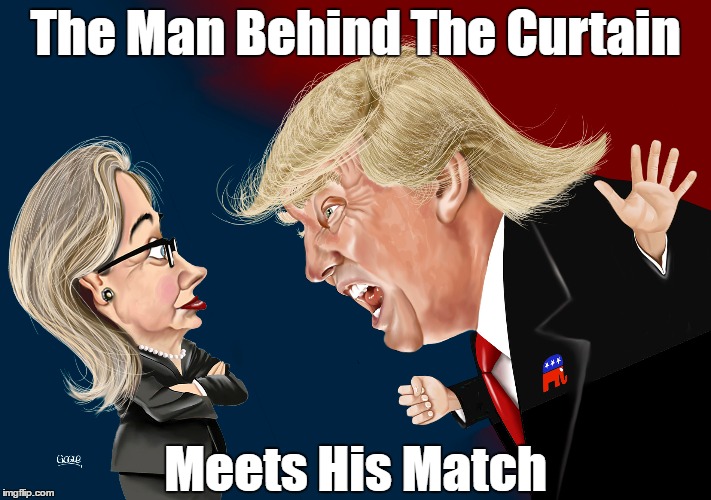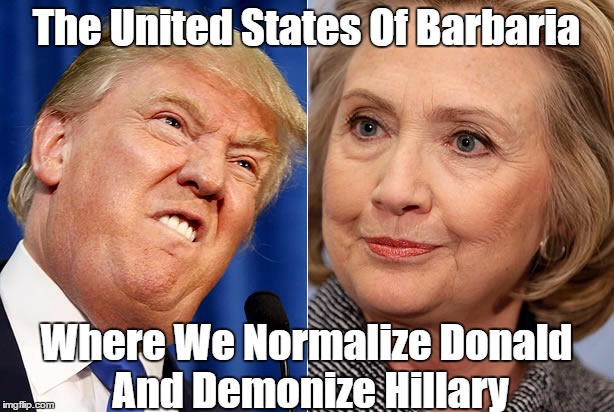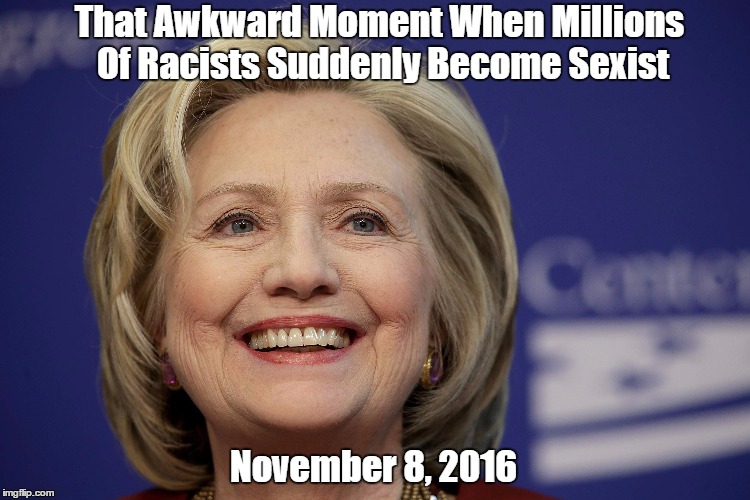
Donald Trump And Hillary Clinton Have Two Very Different Ideas About What It Will Take To Win The White House
Hillary Clinton’s general-election wakeup call came suddenly in May, when loud cursing erupted from her Brooklyn headquarters.
She had just begun a speech to union leaders in Las Vegas when every major cable network had decided to go live to an empty podium in North Dakota, where Donald Trump would soon appear. Waiting for Trump to talk had been deemed more newsworthy than Clinton actually speaking.
“I give up,” one top Clinton aide in Brooklyn muttered to no one in particular. Others rushed to the phones to carp at cable news producers. A staffer sent a message to a reporter explaining the fury of the moment. “HRC,” the person wrote, using the candidate’s initials, “is giving a serious address and all the networks are doing is showing a f—ing podium for three hours.”
But there was a logic to the networks’ decision. No candidate in American history has mastered the media spectacle like Trump, who had locked down the GOP nomination hours earlier. While Clinton read prepared remarks from a TelePrompTer, there was no telling what her opponent might do or say, what demographic he would demonize or which voting bloc he could alienate. It might be impossible and irresponsible to look away. And in that unpredictability, there was power.
While the Clinton camp fumed, the billionaire salesman delivered a vintage performance, equal parts erratic and mesmerizing. He called a U.S. Senator “Pocahontas,” offered nonsensical statistics about windmills killing eagles, entertained the idea of a debate with Democratic candidate Bernie Sanders (which he dropped hours later), and suggested “a lot of people are very skeptical” about the events surrounding the death of Vince Foster, a Clinton friend who committed suicide in 1993.
It was razzle-dazzle domination, a media ambush by the master of reality television. And if Trump has his way, there will be many more moments like this in the five months until Election Day. The heart of his campaign strategy is a plan to monopolize the political conversation and outmaneuver the massive, state-of-the-art campaign that Clinton has built. And that is just one way he is preparing to run a campaign—and beyond that, a Presidential Administration—unlike any before it. “It’s really a microcosm of what can happen in our country,” Trump boasted to TIME of his campaign’s triumphs thus far.


Trump is smashing the conventions of campaigning like a wrecking ball on one of his real-estate projects. He has planned no big fundraising blitz or major TV ad campaign for the fall. He has little interest in the latest advances in data analysis or digital strategy. And despite a personal fortune that runs into the billions, Trump does not want to hire a big staff in the states to get out the vote and to court local leaders. He prefers to talk to reporters and surrogates himself, betting on his own gut and guile. “Trump’s campaign is entirely ad hoc. It’s a guerilla operation built on the concept of mass communication,” says Trump’s longtime political confidant Roger Stone. “The only thing predictable about Donald Trump is that he’s entirely unpredictable.”
By contrast, Clinton’s campaign is modeled on an incumbent reelection effort, with an army of veteran aides, donors and allies already scrambling to position themselves for Administration posts, ambassadorships and possible Cabinet jobs. While Trump speaks off the cuff, nearly every Clinton utterance has been honed by hours of research and deliberation. “Look, we’re never going to be the sexy new thing,” explains one Clinton adviser. “But we also weren’t going to be a surprise, either. Voters know us, warts and all. Can you say that about Trump?”
As a result, the 2016 election looks like an historic mismatch, a battle between the seasoned pro steeped in a tradition she respects and a precedent-smashing newcomer riding on showmanship. Neither of these styles has proven particularly popular: Recent polls show Trump and Clinton are the two least liked major party nominees in modern history. “We are sailing into uncharted waters,” explains GOP strategist Scott Reed, who managed Bob Dole’s 1996 campaign.

It’s a collision of a time-tested strategy and a completely new style. Democratic operatives have compared the matchup to the U.S. military battling the Sunni insurgency in Iraq, a curious analogy, given how well that turned out. Trump allies liken their candidate to Somali pirates running open-water assaults on passing freight ships, an equally strange ambition for a party leader who promises to stamp out terrorism as President.
Both sides are convinced they have the upper hand—and only one can be right.
Trump loves talking about the contrast. In an interview with TIME on June 8 in his Manhattan office overlooking Central Park, he gleefully rattled off the sharp differences in staffing. On this topic, he had no doubt that smaller was better. “We had 73 people. She had 873,” he estimated. “It’s called lean and mean.” His numbers understated his staff and overstated hers, but the ever-fluctuating ratio stands at about 6-to-1.
For Trump, the idea of hiring an aide whom he might never meet is a recipe for waste. “Hillary’s campaign is crazy,” he continued. “I look at her staffing, and I mean she’s got the United States government there.” He even mocks her focus on putting out so many policy proposals, a longtime tradition for major party nominees. “She’s got people that sit in cubicles writing policy all day. Nothing’s ever going to happen. It’s just a waste of paper.” (The Clinton campaign counts that paper as a point of pride: 73,645 words of policy and counting.)
It’s an ironic pose for a businessman who built his brand on flaunting size, wealth and charisma. But it’s also a pitch that Trump plans to bring to voters in the fall. A candidate who can run a frugal and effective campaign, he says, can also run a frugal and effective government, though that same frame means he doesn’t need to give specifics. “My voters don’t care and the public doesn’t care,” Trump says. “They know you’re going to do a good job once you’re there.” His theory of the race echoes advice given to salesman for Trump University, the shuttered seminar program that is now the subject of class-action lawsuits. “You don’t sell products, benefits or solutions,” the school’s training manual read. “You sell feelings.”
Twenty stories below Trump’s office sits his campaign headquarters, which occupy a few ragtag rooms once used to produce his television show “The Apprentice.” To campaign manager Corey Lewandowski, the exposed utility pipes, unpainted walls and concrete floors are proof that leanness pays off. “No one thought what we did was possible,” Lewandowski marvels, sitting at a desk decorated with a framed photo of the original six members of the campaign team. For months, that small group held the campaign together during Trump’s stunning ascent. “With Mr. Trump,” Lewandowski says, “you don’t need a big team.”
Trump is putting that proposition to the test. Despite the media deluge, he employs just one communications aide, who has never before worked in politics. He’s frustrated GOP officials by refusing to make fundraising calls or woo party power-brokers in person. He seldom holds more than one public event in a day—nearly always a packed arena—and shacks up almost every night at home in Trump Tower or in one of his trophy properties. And he’s churned through the campaign hands that party elders have lobbied to install in efforts to professionalize Trump’s circle.
Trump and Lewandowski believe they can succeed simply by replicating the media domination that lifted the campaign to a primary victory. But the same approach carries serious risks. In early June, Trump grabbed headlines by questioning the fairness of a federal judge, Gonzalo Curiel, who is overseeing a class-action lawsuit against Trump University. “He’s a Mexican,” Trump said of Curiel, a U.S. citizen who was born in Indiana to parents of Mexican descent. “We’re building a wall between here and Mexico.”
The fury over these comments once again stood to overshadow Clinton’s well-constructed attack on Trump’s foreign policy. But this time the strategy backfired. Republican leaders uniformly condemned or distanced themselves from Trump’s suggestion that ethnicity itself could make someone biased or unfit for their job, an idea that federal courts have long rejected. Sen. Mark Kirk, a Republican running for re-election in Illinois, rescinded his endorsement. House Speaker Paul Ryan called the claim a “textbook definition of a racist comment.”
Trump was eventually forced to retreat, first by issuing a statement saying his comments had been “misconstrued,” and then by scrapping his freewheeling address to reporters on the night of the California primary for a rare, cautious TelePrompTer-guided speech designed to calm the nerves of fellow Republican leaders. “I understand the responsibility of carrying the mantle and I will never, ever let you down,” he said.
Back in Trump Tower a day later, however, he remained uncowed and unapologetic. The campaign strategy, he made clear, would not change. “I was surprised and disappointed,” he said of the rebukes from Ryan and Senate Majority Leader Mitch McConnell. “But you know, they have to say what they have to say. I’m a big boy.”
The TelePrompTer, he continued, was only appropriate for that specific moment. It would reappear, but not often. The impulse campaign would continue, Trump adviser Paul Manafort says, with more focus on Clinton. The audiences are coming, and they have an expectation to be entertained. “In Tampa in front of 25,000 people, I don’t think it would be the right kind of speech,” Trump added, previewing a rally set for June 11. “That’s not what they want to hear.”
Clinton’s response to the Curiel episode was a preview of the battles to come.When the former Secretary of State finally got a chance to watch Trump’s comments, all she could do was shake her head. Her campaign operation moved quickly on a strategy to respond. Within hours, it mailed video of Trump’s comments to supporters with the subject line, “Everyone Should Take 5 Minutes to Watch This.” Almost 300,000 people did.
Since the early shock of the empty-podium episode, Clinton’s camp has settled on a game plan for the fall. The goal: turn the brash showmanship Trump sees as his strength into a disqualifying weakness. “Donald Trump assumes that what works for his primary voters and works for the people in his crowds will work with the majority of voters,” says a second Clinton campaign insider. “It’s a very self-selecting sample that doesn’t reflect all voters.”
Even in the massive rallies that make Trump so proud, Clinton’s team senses weakness. Sure, the events make for good TV. But his supporters rush through lines without the campaign making any sort of a personal connection, such as asking them to volunteer. At Clinton events, her campaign sells bumper stickers to build a massive list of supporters they can hit up later to make calls and knock on doors. The sidewalks outside of Trump events are packed with independent vendors looking to sell those wares and make a buck for themselves.
The former Secretary of State has been challenged by Trump’s off-the-cuff approach. Still stung by her 2008 primary defeat, she aims to leave little to chance, adopting a risk-averse strategy toward strangers and the press. Early on there were no mass rallies, just scripted conversations with handpicked supporters. Over three months this spring, she spoke for a total of just 45 minutes with traveling reporters—roughly the length of Trump’s press conference in North Dakota.


With her large campaign apparatus comes the burdens of managing it. Turf wars and differences of opinion abound, particularly on the question of how to take on Trump. Aides struggled with whether to try to define Trump as a conservative ideologue, a bully or a fraud. The presence of so many seasoned advisers limits mistakes, but some worry it has turned the campaign into a lumbering bureaucracy. “It’s like the post office,” said one top Obama veteran. It’s a headache for the aides who joined the campaign hoping it would be more like The West Wing than Veep.
The contrast in style and strategy will soon appear across swing states. Clinton’s biggestsuper PAC supporter, Priorities USA, has already reserved more than $135 million in ads, including almost $100 million on television. The group is already on the air in seven battlegrounds—Colorado, Florida, Iowa, Nevada, New Hampshire, Ohio and Virginia—and will stay there through November, all while pumping tens of millions of additional dollars into digital advertising on Facebook, Google search, Snapchat, Pandora and more. “We’re going to be everywhere,” says Guy Cecil, the group’s chief strategist. “It’s really important that we are not just relying on traditional broadcast television, which reaches fewer and fewer people each election cycle.”
Political strategists say it is unlikely that Trump will escape this onslaught unharmed, even if he continues to grab far more press attention than Clinton. “It’s not clear that free media is a substitute,” says Lynn Vavreck, a political scientist at UCLA. “The effects of ads are very small, but they will add up.” In other words, all exposure is not equally as valuable.
That’s why a network of pro-Trump groups is now taking root. At least 15 super PACs have been established to support Trump, according to a list compiled by the Center for Responsive Politics. Separate groups have hung their shingles promising to shore up Trump’s standing with everyone from women to the Amish. Some have raised little or no money, but a handful could spend at least the seven figures to bolster a billionaire. “Does he have to spend $1 billion to match Hillary’s $1 billion? No,” says Doug Watts, a former Ben Carson aide who now serves as executive director of the Committee for American Sovereignty, a pro-Trump super PAC that plans to raise $20 million by the convention and $100 million by November. But he can’t completely surrender the airwaves either.
It’s an old saw in politics that the race for the White House offers a glimpse of how a candidate would govern. And in every modern presidential election, voters have rewarded campaigns that look like Clinton’s: steady and careful, almost a shadow Administration in waiting. The question is whether a fed-up electorate is finally ready to chuck the formula for the experiment Trump promises.
It’s an old saw in politics that the race for the White House offers a glimpse of how a candidate would govern. And in every modern presidential election, voters have rewarded campaigns that look like Clinton’s: steady and careful, almost a shadow Administration in waiting. The question is whether a fed-up electorate is finally ready to chuck the formula for the experiment Trump promises.
Democrats are convinced that the magic will fade as the stakes become clearer. “So much of what gets him coverage is his rhetoric,” said Jon Summers, a Democratic strategist who was a top adviser to Senate Democratic Leader Harry Reid. “That gets people talking about him. I think that’s going to wear on people. We’ve got five months, and that’s such a long time in politics.” Yet after months of proving critics wrong, it would be foolish to dismiss him. “In New Hampshire I spent a million dollars. Bush spent $5 million,” Trump explains. “I was first in a landslide and he was seventh.”

For all of Trump’s efforts to break the mold, there is evidence the race may become a conventional slog. Despite the Republican’s boasts of redrawing the map—flipping manufacturing states in Midwest and the blue bastions of the Northeast—the election is still likely to come down to the same handful of battlegrounds. Partisanship still reigns: there is little evidence that Democrats are ditching Clinton, nor are large numbers of Republicans abandoning Trump, even as he breaks with GOP orthodoxy on policy. Once again, the election may come down to demographics, motivation and the battle to persuade a tiny fraction of swing voters in a small number of states. And in with a more diverse electorate than ever before, many of those fundamentals favor Clinton.
In the meantime, Clinton is adjusting to Trump’s unconventional style. In a San Diego park on June 2, she took the stage in front of 19 American flags for an address billed as a major foreign policy speech. Instead it was more like a roast. “He says he doesn’t have to listen to our generals or our admirals, our ambassadors and other high officials, because he has – quote – ‘a very good brain,’” Clinton deadpanned.
The biting wit was carefully crafted. Dozens of staff members and outside advisors drafted the message over a matter of weeks. Focus groups in swing states such as Ohio suggested that Trump’s own words were often the most damaging to him. So her speechwriters incorporated the wisdom. Instead of calling him unqualified, she cited his views. The effort was a success: the research paper documenting everything Clinton claimed in the speech turned into one of the most shared items on social media the campaign has produced.
It was a window into how Clinton is learning to cope with Trump’s impulsive candidacy. Just weeks after getting wiped off of television by a Trump presser in North Dakota, she dominated cable television that day. Trump may be right that voters are eager to rip up the presidential rulebook. But she’s not going to let Trump easily upstage her with an empty podium again.
No comments:
Post a Comment